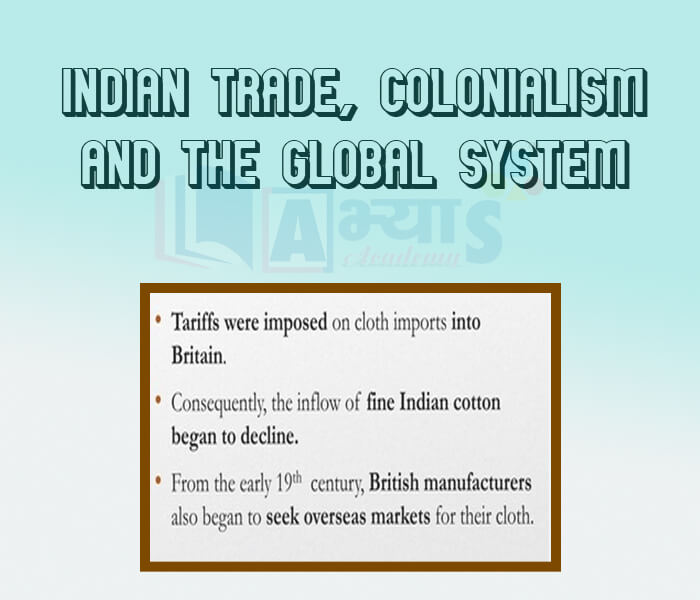Indian Trade, Colonialism and the Global System










Indian Trade, Colonialism and the Global System
Indian Entrepreneurs Abroad: Indian bankers were amongst the many groups of bankers and traders, who financed export agriculture in Central and South-East Asia. They used their own funds or those borrowed from European banks. They developed sophisticated systems to transfer money over large distances. Shikaripuri Shroffs and Nattukottai Chettiars were some famous Indian bankers.
Indian traders and moneylenders also followed European colonisers into Africa. They established flourishing emporia (large retail stores) at busy ports worldwide. They usually sold local and imported curios (rare objects) to tourists.
Indian Trade, Colonialism and the Global System: Fine cottons from India were exported all over the Europe. With industrialisation, British cotton manufacturers began to expand. The industrialists pressurised the government to restrict cotton imports from India and protect local industries.
Indian Trade and Colonialism: The British Government introduced high tariffs on import of cotton cloth. From the early 19th century, British manufacturers also began to seek overseas markets for their cloth. As a result, the Indian textile industry was adversely affected. Indian textile faced stiff competition in other international markets. A steady decline of Indian cotton textile was seen from some 30 per cent around 1800 to 15 per cent by 1815. By the 1870s, this proportion had dropped to below 3 per cent. While exports of manufactures declined rapidly, export of raw materials increased equally fast. Between 1812 and 1871, the share of raw cotton increased from 5 per cent to 35 per cent.
British forced the farmers of India to produce indigo and opium. Indigo used for dyeing cloth was exported to Britain. Opium grown (from the 1820) in India was exported to China. The money earned through opium sale was used by Britain to finance its tea and other imports from China.
Trade Relationship Between India and Britain: Over the 19th century, the British manufactures flooded the Indian market. Food grain and raw material which were exported from India to Britain increased. The value of British exports to India was much higher than the value of British imports from India. Thus, Britain had a trade surplus with India and used this surplus to balance its trade deficits with other countries.
In this way, a multilateral settlement system works. It allows one country's deficit with another country to be settled by its surplus with a third country. India played a significant role in world economy by helping Britain balance deficits. This trade surplus of Britain helped the home changes i.e. private remittances of British officials, traders, interest payments on external debt and pensions of British officials in India.
#Remittance :- An amount of money that is sent as a payment for something .
Students / Parents Reviews [10]
I have spent a wonderful time in Abhyas academy. It has made my reasoning more apt, English more stronger and Maths an interesting subject for me. It has given me a habbit of self studying

Yatharthi Sharma
10thMy experience with Abhyas is very good. I have learnt many things here like vedic maths and reasoning also. Teachers here first take our doubts and then there are assignments to verify our weak points.

Shivam Rana
7thAbhyas Methodology is very good. It is based on according to student and each child manages accordingly to its properly. Methodology has improved the abilities of students to shine them in future.

Manish Kumar
10thA marvelous experience with Abhyas. I am glad to share that my ward has achieved more than enough at the Ambala ABHYAS centre. Years have passed on and more and more he has gained. May the centre flourish and develop day by day by the grace of God.

Archit Segal
7thAbhyas is a complete education Institute. Here extreme care is taken by teacher with the help of regular exam. Extra classes also conducted by the institute, if the student is weak.

Om Umang
10thBeing a parent, I saw my daughter improvement in her studies by seeing a good result in all day to day compititive exam TMO, NSO, IEO etc and as well as studies. I have got a fruitful result from my daughter.

Prisha Gupta
8thIt was a good experience with Abhyas Academy. I even faced problems in starting but slowly and steadily overcomed. Especially reasoning classes helped me a lot.

Cheshta
10thOne of the best institutes to develope a child interest in studies.Provides SST and English knowledge also unlike other institutes. Teachers are co operative and friendly online tests andPPT develope practical knowledge also.

Aman Kumar Shrivastava
10thIt was good as the experience because as we had come here we had been improved in a such envirnment created here.Extra is taught which is beneficial for future.

Eshan Arora
8thAbout Abhyas metholodology the teachers are very nice and hardworking toward students.The Centre Head Mrs Anu Sethi is also a brilliant teacher.Abhyas has taught me how to overcome problems and has always taken my doubts and suppoeted me.
